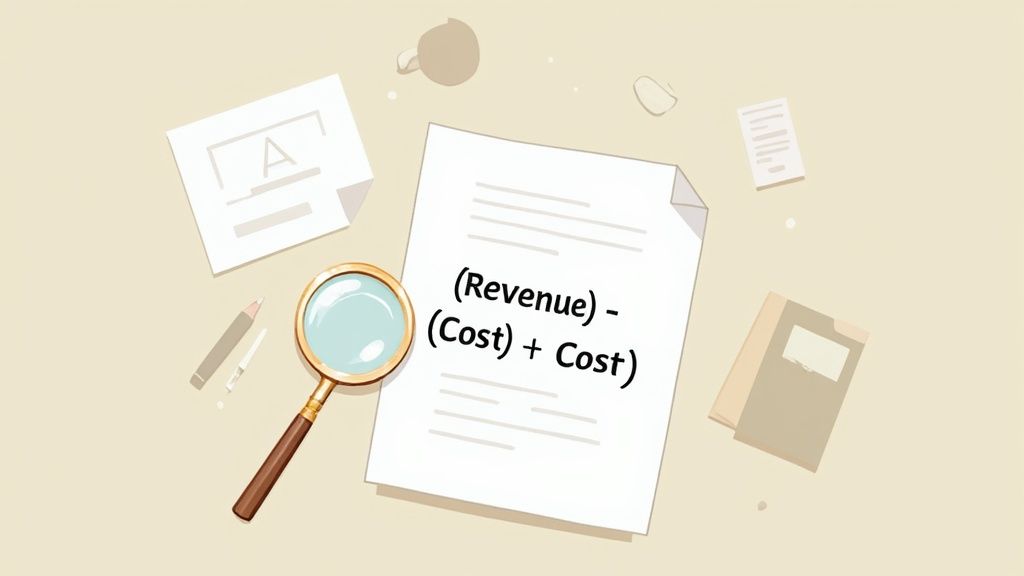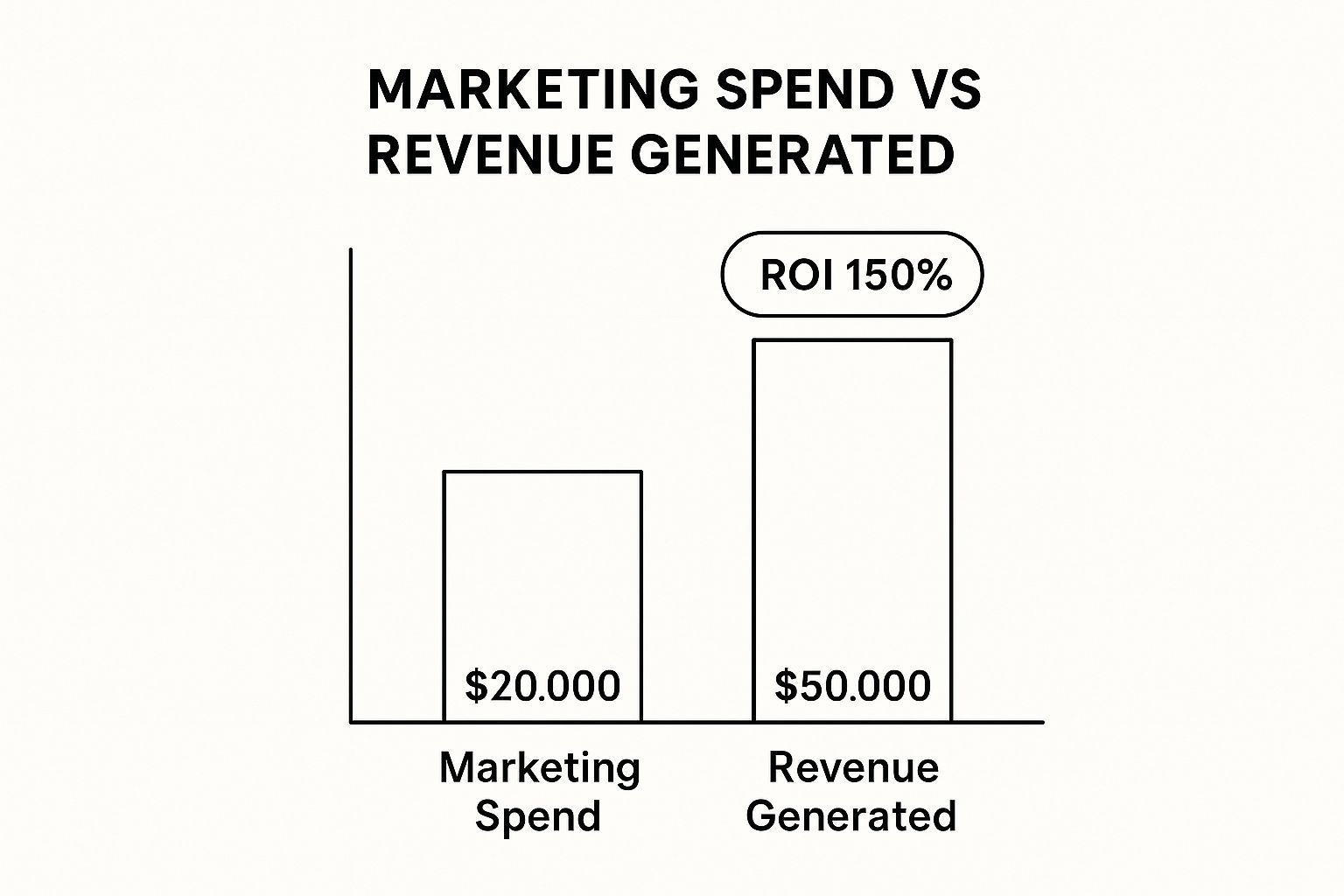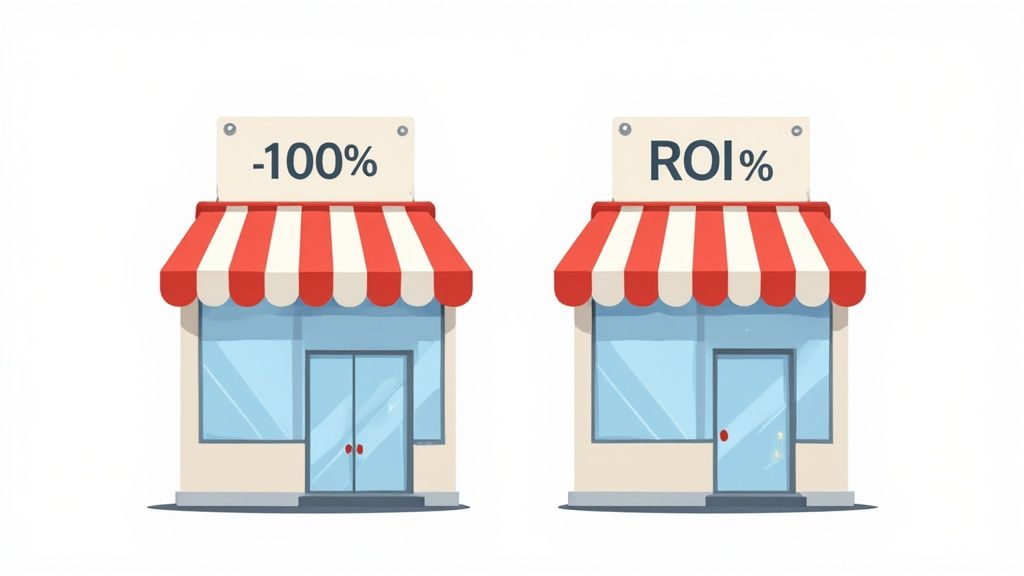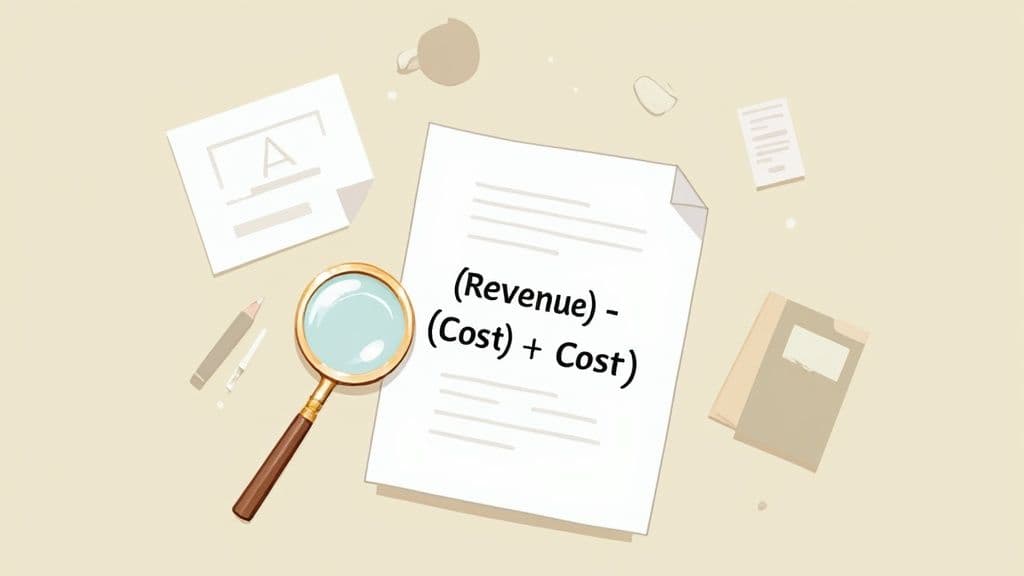Figuring out your marketing ROI is pretty straightforward at its core. You take the sales growth your campaign generated, subtract what you spent on marketing, and then divide that number by your total marketing cost. When you express that as a percentage, you get a clear, powerful number that connects your spending directly to business growth.
This simple calculation does something amazing: it transforms marketing from what some people see as just an expense into a measurable driver of revenue.
Why Measuring Marketing ROI Is Not Optional
Let's be real. Sooner or later, every marketing leader gets asked, "What did we get back from that investment?" When every dollar is being watched, knowing the answer isn't just a good idea—it's how you survive and grow. Measuring your marketing return on investment (ROI) is the single best way to justify your budget, prove your team's impact, and make smarter decisions down the road.
It's the language that the C-suite speaks fluently. Forget trying to impress them with clicks and impressions; when you can show them hard numbers, you position marketing as a vital contributor to the bottom line. For a really good deep dive on this, check out this guide on how to measure marketing ROI for real growth.
From Cost Center to Revenue Engine
Without solid ROI data, marketing often gets stuck with the "cost center" label—a necessary but expensive part of doing business. But when you start consistently tracking and reporting your returns, you completely change that conversation.
Every successful campaign becomes a clear data point showing that your team creates real, tangible value. This makes it so much easier to get the resources and buy-in you need for future projects.
This isn't just a trend; it's the new standard. By 2025, a whopping 83% of marketing leaders are making ROI their top priority. That's a huge jump from just 68% five years ago, and it shows a massive shift toward accountability as budgets get tighter. What's more, 64% of companies are now tying future marketing budgets directly to past ROI performance, making it the key factor in their planning. For more stats on this, Firework.com has some great insights.
When you embrace this data-first approach, you unlock the ability to:
- Optimize Your Spending: You can finally see which channels and campaigns are actually working and move your money there.
- Refine Your Strategy: Learn what truly connects with your audience so you can double down on what's successful.
- Build Credibility: Earn trust from leadership by drawing a straight line from your team’s work to revenue growth.
The ability to calculate and communicate marketing ROI transforms your conversations. You're no longer just asking for a budget; you're presenting a clear investment opportunity with a predictable return.
Ultimately, getting good at measuring ROI is about more than just crunching numbers. It's about building a sustainable, results-focused marketing department that proves its worth time and time again.
If you're just starting to get a handle on your spending, using a small business budget template can give you the structure you need to track costs accurately from the very beginning.
The ROI Formulas That Actually Matter
You don't need a PhD in mathematics to calculate marketing ROI. Honestly, the formulas that really count are surprisingly simple. Once you get the hang of them, you're on your way to directly connecting your marketing spend to real revenue.
At its heart, ROI is just a comparison of what you got back versus what you put in. We'll start with the most basic formula and then layer in some details for a much sharper picture of your campaign's true profitability.
The Foundational ROI Formula
This is the classic, go-to formula for a quick pulse check on your return. It pits the sales growth you generated directly against your campaign cost. It's the perfect place for any marketer to start.
Here's the simple math:
(Sales Growth – Marketing Cost) / Marketing Cost = Marketing ROI
Just multiply the result by 100 to get your percentage. This number instantly tells you how much you earned for every dollar you spent. For example, an ROI of 300% means you pocketed $3 in profit for every $1 you put into the campaign.
Let's see how this works in the real world.
Example: A B2B Google Ads Campaign
Picture a software company that drops $10,000 on a Google Ads campaign to reach logistics managers. Over the next few months, they track the leads and can directly attribute $40,000 in new customer contracts to those specific ads.
Plugging that into the formula:
- ($40,000 Sales Growth – $10,000 Marketing Cost) / $10,000 Marketing Cost = 3
- 3 x 100 = 300% ROI
That’s a straightforward and powerful way to show your work is paying off. But it’s not the full story.
Getting a More Accurate ROI by Including COGS
The basic formula is a great start, but it skips over a huge piece of the financial puzzle: the Cost of Goods Sold (COGS). This is what it actually costs you to produce the product or deliver the service you sold—things like raw materials and direct labor. If you ignore it, your ROI can look way better than it actually is.
Factoring in COGS means you’re measuring the return on your actual profit, not just revenue. It’s a game-changer for accuracy.
This visual from Wikipedia breaks down how the different financial components fit together to give you a true return on your marketing investment.

As you can see, subtracting the cost of the goods themselves is what gives you a real sense of the financial gain from your marketing budget.
Here’s the more precise formula to use:
(Sales Growth – Cost of Goods Sold – Marketing Cost) / Marketing Cost = Marketing ROI
This gives you a much clearer view of profitability. You're no longer just asking, "Did we make money?" Instead, you're asking, "How much profit did our marketing actually generate?"
Example: An E-commerce Influencer Collaboration
Let's say an online activewear brand pays an influencer $5,000 to promote a new clothing line. The campaign drives $25,000 in sales. The COGS for that batch of products—manufacturing, packaging, and shipping—totaled $8,000.
Time to do the math:
- Sales Growth: $25,000
- Marketing Cost: $5,000
- Cost of Goods Sold (COGS): $8,000
Now, we run these numbers through our more accurate formula:
- ($25,000 – $8,000 – $5,000) / $5,000
- $12,000 / $5,000 = 2.4
- 2.4 x 100 = 240% ROI
See the difference? Without COGS, the ROI would have looked like an incredible 400%, which is flat-out misleading. This more honest calculation gives the team a realistic view of how the campaign truly performed.
Of course, ROI is a critical number, but it's just one part of the story. To get the complete picture, you need to understand all the content performance metrics that feed into your success.
Building Your ROI Measurement Framework

Knowing the formulas for ROI is one thing, but the real work lies in building a system that consistently feeds them clean, reliable data. Without a solid measurement framework, your calculations are just educated guesses built on a shaky foundation.
Think of this framework as your single source of truth. It's the engine that eliminates guesswork and connects every single marketing action to a tangible business outcome. It's what gives you the power to actually measure ROI with confidence.
Start with Crystal-Clear Campaign Goals
Before you even think about tracking a click, you have to define what winning looks like. Every campaign, whether it’s a massive product launch or a simple social media contest, needs a specific, measurable objective that ties directly back to what the business wants to achieve.
Fuzzy goals like "increase brand awareness" or "get more leads" just don't cut it. They're impossible to measure against, which means you can't calculate a meaningful return.
You need to get specific. For example:
- Lead Gen: "Generate 150 qualified leads for our enterprise software trial in Q3."
- E-commerce: "Achieve a 4:1 Return on Ad Spend (ROAS) from our Memorial Day sale."
- Content Marketing: "Source $75,000 in new sales pipeline from our blog content over the next six months."
See the difference? These goals are specific, measurable, and have a deadline. They give your ROI calculation a clear finish line.
Implement Your Tracking Essentials
Okay, you've got your goals. Now you need the technical plumbing to track your progress. This is where a lot of marketers stumble, but getting these fundamentals right is absolutely non-negotiable for accurate ROI measurement. The aim here is to create a digital breadcrumb trail, from the very first ad they see to the final sale.
Two of the most critical tracking tools in your arsenal are:
-
UTM Parameters: These are just simple tags you add to the end of your URLs. They act like little signposts, telling your analytics tools exactly where your traffic is coming from. If you use them consistently, you can see which campaigns, channels, and even which specific ads are driving your most valuable traffic.
-
Conversion Pixels: These are tiny snippets of code you place on key pages of your website—think the "thank you" page after someone fills out a form. Whether it’s a pixel from Meta, Google, or LinkedIn, it's essential for connecting your ad spend directly to conversions.
By diligently using UTMs and pixels, you move from wondering which channels work to knowing precisely how much revenue each one generates. It’s the difference between flying blind and having a full instrument panel.
Choosing the Right KPIs for the Job
Your Key Performance Indicators (KPIs) are the specific metrics you’ll watch to see how you’re doing against your goals. And this is important: the KPIs you choose must align with the type of campaign you're running. If you use the wrong metrics, you’ll get a completely distorted view of your performance.
A brand awareness campaign and a direct sales campaign are trying to do two very different things, so they naturally need different KPIs.
| Campaign Type | Primary Goal | Key KPIs to Track |
|---|---|---|
| Brand Awareness | Increase visibility and reach | Impressions, Social Media Reach, Branded Search Volume |
| Lead Generation | Capture new prospect information | Cost Per Lead (CPL), MQLs, Form Submissions |
| Direct Sales | Drive immediate revenue | Return on Ad Spend (ROAS), Customer Acquisition Cost (CAC) |
Choosing the right KPIs ensures you're measuring what actually matters for that specific initiative. This is what leads to a much more accurate and relevant ROI calculation, helping you understand the true impact of all your different marketing efforts.
Connect Your Data Pipeline
Last but certainly not least, your data can't live on separate islands. Your analytics platform, your CRM, and your advertising dashboards all need to talk to each other to paint a complete picture of the customer journey. I can't tell you how many times I've seen a disconnected tech stack become the biggest barrier to proving marketing ROI.
For instance, Google Analytics can show you which campaign drove a website visitor, but it can’t tell you if that visitor eventually became a high-value customer. You only get that piece of the puzzle by connecting it to your CRM, like Salesforce or HubSpot.
This integration is what allows you to follow a lead from their first click on an ad all the way to a closed-won deal. That's how you get the full revenue picture you need for an airtight ROI calculation. Tools like Postiz, with its detailed analytics, can be a crucial part of this pipeline, showing how your social media efforts contribute to that broader customer journey and ultimately impact the bottom line.
Choosing the Right Attribution Model
Let's be honest, the customer journey is almost never a straight line. Someone might see your brand on a social media post, read a blog article a week later, click on a paid ad the following month, and finally make a purchase after getting a targeted email. If you only credit that final email, you’re missing the real story of what actually guided their decision.
This is exactly why marketing attribution is so critical. It’s the method you use to give credit where credit is due for each touchpoint along that winding path. Picking the right model is absolutely fundamental to getting an accurate ROI calculation, as it directly decides which channels get the credit—and, more importantly, the budget.
Most people start with last-click attribution, which gives 100% of the credit to whatever the customer did right before converting. It's simple, but it’s also a dangerously incomplete picture. It heavily favors bottom-of-the-funnel tactics and completely ignores all the hard work your other channels did to build awareness and trust early on.
This infographic gives a great high-level view of marketing investment versus return. The entire calculation hinges on having the right attribution model in place.

While the visual makes calculating ROI look easy, the real magic is in making sure the revenue is credited to the marketing efforts that actually drove it. That's all about attribution.
A Practical Guide to Attribution Models
To get a true sense of what's working, savvy marketers look beyond last-click and use multi-touch attribution models. These models are designed to distribute credit across several touchpoints, giving you a much more balanced and realistic view of your marketing ecosystem.
Deciding which model to use can feel overwhelming, but it really comes down to your sales cycle and business goals. This table breaks down the most common options to help you find the right fit.
| Attribution Model | How It Works | Best For |
|---|---|---|
| Linear | Spreads credit evenly across every single touchpoint in the journey. | Long sales cycles where you want to value consistent engagement and brand presence. |
| Time-Decay | Gives more credit to the touchpoints that happened closer to the final conversion. | Shorter, high-intensity campaigns (like a holiday sale) where recent interactions matter most. |
| Position-Based (U-Shaped) | Assigns 40% of the credit to the first touch and 40% to the last, with the remaining 20% shared among the middle interactions. | Businesses that value both the initial discovery (first touch) and what ultimately closed the deal (last touch). |
Ultimately, no single attribution model is a silver bullet. The goal is to choose a model that reflects how your customers genuinely interact with your brand, moving beyond the limitations of last-click to appreciate the full journey.
My Take: I always advise clients to start by moving away from last-click. Even a simple Linear model is a huge step up because it forces you to acknowledge that top-of-funnel activities have real value. Test a few models and see which one tells a story that aligns with what you're seeing on the ground.
The Rise of AI in Attribution
Just as we were getting comfortable with multi-touch models, AI came along and changed the game again. Traditional, rule-based attribution is being replaced by smarter, AI-driven approaches that can analyze thousands of unique customer paths at once. These systems can spot subtle patterns in the data that humans would miss, assigning credit with far greater accuracy.
It's not just hype. It's expected that 30% of businesses will adopt AI-driven analytics tools by 2025 to get a clearer picture of ROI. And the results are impressive—AI models have shown 67% greater accuracy in forecasting campaign success than their rule-based counterparts.
For example, one beverage company used AI attribution and discovered its podcast ads were generating 22% more conversions than their old last-click data ever showed. This is a perfect example of how AI can uncover the hidden influence of your marketing channels. You can find more examples of the power of AI in digital marketing ROI in practice.
These AI models don't just follow a set of rules; they learn and adapt over time, giving you an ever-clearer view of what's really driving your bottom line.
How to Navigate a Cookieless Future
Another massive shift on the horizon is the death of the third-party cookie. For years, we’ve relied on cookies to track users across the web, but growing privacy concerns are bringing that era to a close. This makes connecting the dots in a customer's journey much, much harder.
So, how do you keep measuring ROI effectively? The answer is first-party data. This is the information you collect directly from your audience on your own turf—your website, your app, your email list.
Here are a few practical ways to prepare for this shift:
- Build Your Data Hub: Give people a reason to create accounts, subscribe to your newsletter, or download a resource. Every interaction is a chance to gather valuable first-party data.
- Put Your CRM to Work: Your CRM should be the central nervous system for your customer data. It’s where you can track every interaction with known leads and customers without relying on cookies.
- Embrace Contextual Advertising: Instead of chasing users around the web, place your ads on websites and platforms where the content is directly relevant to what you sell. It's a classic strategy that's becoming new again.
In this new privacy-first world, building direct relationships with your audience is everything. The stronger your first-party data strategy is, the more accurate and resilient your ROI measurement will be. Combine that with a smart attribution model, and you'll be well-equipped to prove your marketing's value, no matter what changes come next.
How to Measure Social Media ROI

Trying to measure the return on your social media efforts can feel like trying to catch smoke. How do you actually connect a 'like' or a 'share' to real dollars in your bank account? It’s definitely trickier than tracking a paid ad click, but it's far from impossible.
The secret is to stop obsessing over vanity metrics alone. Instead, you need a solid framework that accounts for both the direct sales you can see and the long-term, indirect value your social presence builds over time.
It’s a common struggle. Even though platforms like Facebook are seen as delivering the highest ROI by 28% of marketers, a late 2024 survey showed that only 30% of them actually feel confident in their ability to measure it. That's a huge gap, especially when you consider that social content has a massive influence on spending—a whopping 81% of consumers say they make spontaneous purchases multiple times a year after seeing social posts. You can read more about the connection between social media and consumer spending in this research.
Tracking Direct Conversions from Social Media
The cleanest, most straightforward way to see your social media ROI is by tracking direct sales and leads. This is your hard data—the undeniable proof that what you’re doing is generating an immediate return.
To nail this, you have to use the right tools for the job. You need features specifically designed to turn a scroll into a sale.
Here’s where to start:
- Lean into Shoppable Posts: Platforms like Instagram and Facebook let you tag products right in your posts. This creates a super smooth path from discovery to purchase, making it dead simple to see where the sale came from.
- Get Serious About UTM Parameters: Every single link you share on social media, whether it’s to a blog post or a product page, should have a unique UTM code. This is how you tell your analytics software exactly which platform, campaign, and even which specific post drove that traffic and any resulting conversions.
- Use the Ad Managers: Tools like Meta Ads Manager and LinkedIn Campaign Manager come with powerful conversion tracking pixels. Pop one on your website, and you'll see exactly how many leads or sales your paid social campaigns are bringing in.
Pro Tip: Never, ever send campaign traffic to your generic homepage. Always use a dedicated landing page for your social campaigns. It makes isolating conversions and calculating an accurate ROI so much easier.
Assigning Value to the 'Softer' Metrics
Okay, this is where most marketers get tripped up. What’s the dollar value of a new follower? Or a boost in brand sentiment? While these are often called 'soft' metrics, they have a very real, tangible impact on your business down the road. The trick is to assign a monetary value to them based on your own historical data.
This takes a bit more legwork, but it gives you a much more complete picture of your true social media ROI.
Calculating the Value of a New Follower
Start thinking of a new follower as a potential long-term customer, not just a number on your profile. To put a price tag on that, you just need to connect the dots between your followers and your actual sales.
Here’s a simple way to frame it:
- Find Your Follower-to-Customer Rate: Look at your data from the last six months or so. What percentage of your new customers also follow you on social media? Let's say you find that 1% of your new followers eventually become paying customers. That's your rate.
- Know Your Customer Lifetime Value (LTV): On average, how much does a customer spend with you over their entire relationship with your brand? For this example, let's say your LTV is $500.
- Do the Math: Now, just multiply your conversion rate by your LTV. In our example, 1% of $500 is $5. So, every new follower is worth approximately $5 to your business.
Suddenly, a vanity metric is transformed into a concrete business asset. From here, you can start tracking the ROI of campaigns designed specifically to grow your audience and know what that growth is actually worth.
Connecting these dots is a crucial step in understanding the true impact of your work. You can dive deeper into this by reading our guide on understanding social media ROI to build out an even more detailed framework.
A Few Common Questions About Measuring Marketing ROI
Even when you have the formulas down, real-world questions always pop up. It’s one thing to know the math, and another to apply it when things get messy. Let’s walk through some of the most common hurdles I see people face and get you some clear, practical answers.
How Often Should I Actually Be Measuring ROI?
This is a big one, and the right answer really hinges on your sales cycle and the type of campaign you're running. There’s no single correct answer, but here are some solid rules of thumb to keep you on track.
If you’re running a short-term campaign with a fast sales cycle—think an e-commerce flash sale or a quick lead magnet promotion—you’ll want to check in weekly, or even daily. This lets you make quick pivots on your ad spend and creative while the campaign is still live, maximizing your return on the fly.
But for your long-game strategies, like SEO or B2B content marketing, the story is completely different. These efforts can take a good 6-12 months to really bear fruit financially. Reporting monthly or quarterly makes a lot more sense here. This gives your work time to mature and lets you track leading indicators—like organic traffic growth and lead quality—that you know will eventually turn into revenue.
My advice? Find a reporting rhythm that matches the natural pace of your business. Keep an eye on daily metrics with automated dashboards, but save the deep-dive ROI analysis for a weekly, monthly, or quarterly review. This keeps you in the loop without drowning you in data.
What’s a Good Marketing ROI, Anyway?
Ah, the million-dollar question. The honest-to-goodness answer is: it depends. A "good" ROI is incredibly specific to your industry, business model, and especially your profit margins.
You’ll often hear a 5:1 ratio thrown around as a solid benchmark, which works out to a 500% ROI. Basically, you're making $5 in revenue for every $1 you spend. It’s a great target to aim for, but it’s definitely not a universal standard.
Here are a few things that can change what "good" looks like for your business:
- High-Margin Businesses: If you're selling something with high margins, like enterprise software or professional consulting services, you can and should aim higher. An ROI of 10:1 (1000%) isn't out of the question.
- Low-Margin Businesses: For e-commerce or retail businesses with tighter margins, a 2:1 (200%) or 3:1 (300%) ROI can be a huge success, especially when you're dealing with high sales volume.
- Growth Stage: Is your company a startup focused on grabbing market share? You might be perfectly happy with a break-even ROI if it means you're acquiring new customers at a rapid clip.
How Do I Figure Out the ROI for Content Marketing and SEO?
I get it—measuring the ROI for long-term channels like content and SEO can feel like trying to nail Jell-O to a wall. Their impact is often indirect and builds slowly over time. You can’t just point to a single blog post and connect it to a sale that happened the same day. You have to learn to connect the dots over a longer timeline.
The secret is to track how these channels contribute to actions that actually make you money.
- Attribute Your Leads: Dig into your analytics and see how many leads or demo requests came from organic search or a specific blog post.
- Figure Out Lead Value: Put a dollar value on each lead. You can do this by looking at your historical lead-to-customer conversion rate and your average customer lifetime value (LTV).
- Add It All Up: Multiply the number of leads you generated by that lead value, and you’ve got your total revenue contribution.
For instance, let’s say a blog post cost you $1,000 to produce. It ended up generating 20 qualified leads, and you know from past data that each lead is worth about $150 to your business. The total value generated from that post is $3,000, giving you a 200% ROI. It’s not direct, but it’s a solid way to prove its worth.
What Are the Biggest Mistakes I Should Avoid?
Knowing the common pitfalls is half the battle. When it comes to calculating marketing ROI, I see marketers stumble in a few key areas that really skew their results and lead to some bad decisions.
One of the most common errors is ignoring all the costs. It’s easy to just look at your ad spend, but what about the salaries of your team, the software you use, or the cost of creating the content? Forgetting these things will seriously inflate your ROI and give you a false sense of profitability.
Another classic mistake is using the wrong attribution model. If you only look at the last click before a conversion, you’re completely ignoring all the other touchpoints that nurtured that customer along their journey. You might end up cutting the budget for a channel that’s quietly doing all the heavy lifting at the top of the funnel. Make sure you choose a model that actually reflects how your customers buy from you.
Ready to stop guessing and start seeing the real impact of your social media? Postiz offers a complete suite of scheduling, creation, and analytics tools to help you measure what truly matters and prove your marketing ROI. Unify your social media workflow and get actionable insights today.





